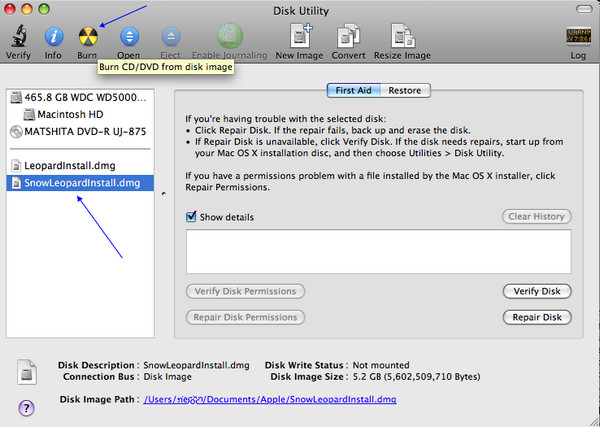
Use Terminal App to Create a Bootable macOS Big Sur USB Drive. In this method, we will. From the Mac Finder, select a disk image file Pull down the “File” menu and choose “Burn Disk Image (Name) to Disc” Insert a blank DVD, CD, or CDRW disc into the drive, then click on the “Burn” button You can also access the “Burn Disk Image to Disc” option by right-clicking on an image file. In the popup that appears, select your destination drive, which is the USB flash drive you want to burn the DMG file to. Click 'Burn' in the popup window. Once the process is complete, remove the USB stick and use it to install the application associated with that DMG on any other Mac computer. Mac disk image file. Burn DMG to USB on MAC This method may vary depending on which Mac OS version you are currently running, but the overall concept is same for all. The in-built disk utility on Mac is ideal for burning DMG to USB. Once the DMG is burnt, the USB drive, now bootable can be used as an installer on any other mac System.
This guide covers the verbatim copying of a DMG image to a USB thumb drive using only Linux (no need to find a Mac). Hypersonic plugin free download zip. If the DMG was intended to be bootable then the resulting USB will be bootable.
Convert to ISO

Burn Dmg To Usb Mac Terminal Free
Linux doesn’t much care for DMG files. Sure, it’ll play nice with them. But we don’t just want to play nice. We want to copy a DMG image to a USB drive and keep it as verbatim as computationally possible. In order to do this, we’re first going to convert the image to a format that’s a little more universal: ISO.
We’re going to use dmg2img to convert the DMG to an ISO image. If you already have dmg2img, great. If not, install it using your distribution’s native package management system.
On Ubuntu, you’d do it like this:
Burn Dmg To Usb Mac
Once you have dmg2img installed, begin converting the DMG file:
After a few minutes, you should have a second file called image.img. This file can be used like an ISO. All we have to do is change the extension. Use mv to do this:


Make sure you specified “image.img” and not “image.dmg”! Working with three different file extensions can get kind of confusing.
Ok, so we should now have a file called “image.iso” which is just “image.img” with a different extension.
Now we want to write “image.iso” to our USB drive. I used “lsblk” to figure out how the system was identifying my drive. The lsblk command lists all disks connected to the system. It’s usually pretty easy to figure out which disk is which based on their size. Just be sure you’re sure. This process is going to overwrite the target disk with the contents of our DMG image file. Any preexisting files on the target disk will be lost. As usual, make sure you have a proper backup.
Make sure the target drive isn’t mounted. Unmount the drive with your distribution’s GUI.
Or you could just unmount it from the terminal: Arma 3 altis life map editor download.
Most systems seem to mount external drives in /media. Sometimes the drive might be mounted in /mnt or elsewhere.
Write the ISO image to the USB drive like this:
Replace “X” with the appropriate letter. For example “/dev/sdb”. Be sure to use the drive directly and not a partition within the drive. For example, don’t use “/dev/sdb1”.
This will probably take a little while to complete. I’m using a Kingston DataTraveler DTSE9 and it took about 24 minutes 30 seconds to write 4.9GB. Urdu fonts for ms word.
Your new USB stick should now be bootable, assuming that was the intended purpose of the DMG.